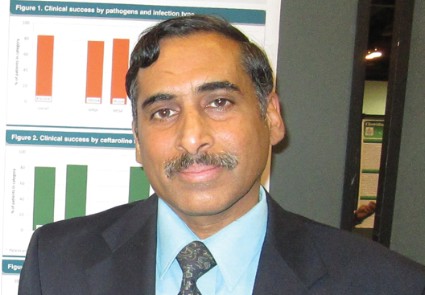User login
DENVER – The clinical success of ceftaroline fosamil exceeded 80% in patients with acute bacterial skin and skin structure infections, including those with underlying comorbidities and those with infections caused by methicillin-resistant Staphylococcus aureus, a multicenter, industry-funded trial demonstrated.
"At one time, MRSA infections used to be a tertiary care phenomenon," Dr. Ananthakrishnan Ramani said in an interview during a poster session at the annual Interscience Conference on Antimicrobial Agents and Chemotherapy.
"Nowadays, MRSA has become a problem in the community as well. We have seen that it’s no longer bacteremia and sepsis, but also bacterial skin and skin structure infections. Ceftaroline fosamil is the only [Food and Drug Administration]–approved cephalosporin which has activity against MRSA. That’s why this medicine is fascinating to me as an internal medicine physician and as an infectious diseases doc, because we know cephalosporins very well," he said.
Developed by Oakland, Calif.–based Cerexa Inc., ceftaroline fosamil was approved in 2010 for the treatment of acute bacterial skin and skin structure infections (ABSSSIs) and community-acquired bacterial pneumonia. The purpose of the current trial, known as CAPTURE, was to retrospectively evaluate information on the routine clinical use of intravenous ceftaroline fosamil in the United States.
At the meeting, Dr. Ramani and his associates presented data limited to 1,030 patients with ABSSSI who were treated with the agent at one of 38 centers from September 2011 through February 2013. They focused their analysis on patient demographics, disease characteristics, antibiotics, pathogens, and outcomes.
Of the 1,030 patients with ABSSSI, mean age was 58 years, mean body mass index was 34 kg/m2, and 54% were male. Nearly two-thirds (73%) were overweight or obese and 46% had diabetes mellitus. The three most common types of infection were deep/extensive cellulitis (59%), major abscesses (19%), and infected ulcers (15%); the most common infections sites were the leg/thigh (47%) and foot (24%) and infected surgical wounds (13%).
Prior to administration of ceftaroline fosamil, 77% of the patients had received antibiotics, and concurrent antibiotics, mostly clindamycin, were used in 37% of cases, said Dr. Ramani, who practices in Catskill, N.Y.
The overall clinical success rate was 85%. It was slightly lower for patients with diabetes (83%) and slightly higher for obese patients (88%). When analyzed by infection type, ceftaroline fosamil therapy achieved clinical success in 86% of major abscesses, 85% of deep/excessive cellulitis cases, 79% of infected surgical wounds, and 79% of infected ulcers, he said.
The researchers also found that clinical success was achieved in 80% of patients with diabetes and MRSA and in 83% of obese patients with MRSA. In addition, clinical success in MRSA infections with ceftaroline fosamil monotherapy was 83%, while success with concurrent therapy was 76%.
Cerexa funded the trial. Dr. Ramani has received research funding from the company.
DENVER – The clinical success of ceftaroline fosamil exceeded 80% in patients with acute bacterial skin and skin structure infections, including those with underlying comorbidities and those with infections caused by methicillin-resistant Staphylococcus aureus, a multicenter, industry-funded trial demonstrated.
"At one time, MRSA infections used to be a tertiary care phenomenon," Dr. Ananthakrishnan Ramani said in an interview during a poster session at the annual Interscience Conference on Antimicrobial Agents and Chemotherapy.
"Nowadays, MRSA has become a problem in the community as well. We have seen that it’s no longer bacteremia and sepsis, but also bacterial skin and skin structure infections. Ceftaroline fosamil is the only [Food and Drug Administration]–approved cephalosporin which has activity against MRSA. That’s why this medicine is fascinating to me as an internal medicine physician and as an infectious diseases doc, because we know cephalosporins very well," he said.
Developed by Oakland, Calif.–based Cerexa Inc., ceftaroline fosamil was approved in 2010 for the treatment of acute bacterial skin and skin structure infections (ABSSSIs) and community-acquired bacterial pneumonia. The purpose of the current trial, known as CAPTURE, was to retrospectively evaluate information on the routine clinical use of intravenous ceftaroline fosamil in the United States.
At the meeting, Dr. Ramani and his associates presented data limited to 1,030 patients with ABSSSI who were treated with the agent at one of 38 centers from September 2011 through February 2013. They focused their analysis on patient demographics, disease characteristics, antibiotics, pathogens, and outcomes.
Of the 1,030 patients with ABSSSI, mean age was 58 years, mean body mass index was 34 kg/m2, and 54% were male. Nearly two-thirds (73%) were overweight or obese and 46% had diabetes mellitus. The three most common types of infection were deep/extensive cellulitis (59%), major abscesses (19%), and infected ulcers (15%); the most common infections sites were the leg/thigh (47%) and foot (24%) and infected surgical wounds (13%).
Prior to administration of ceftaroline fosamil, 77% of the patients had received antibiotics, and concurrent antibiotics, mostly clindamycin, were used in 37% of cases, said Dr. Ramani, who practices in Catskill, N.Y.
The overall clinical success rate was 85%. It was slightly lower for patients with diabetes (83%) and slightly higher for obese patients (88%). When analyzed by infection type, ceftaroline fosamil therapy achieved clinical success in 86% of major abscesses, 85% of deep/excessive cellulitis cases, 79% of infected surgical wounds, and 79% of infected ulcers, he said.
The researchers also found that clinical success was achieved in 80% of patients with diabetes and MRSA and in 83% of obese patients with MRSA. In addition, clinical success in MRSA infections with ceftaroline fosamil monotherapy was 83%, while success with concurrent therapy was 76%.
Cerexa funded the trial. Dr. Ramani has received research funding from the company.
DENVER – The clinical success of ceftaroline fosamil exceeded 80% in patients with acute bacterial skin and skin structure infections, including those with underlying comorbidities and those with infections caused by methicillin-resistant Staphylococcus aureus, a multicenter, industry-funded trial demonstrated.
"At one time, MRSA infections used to be a tertiary care phenomenon," Dr. Ananthakrishnan Ramani said in an interview during a poster session at the annual Interscience Conference on Antimicrobial Agents and Chemotherapy.
"Nowadays, MRSA has become a problem in the community as well. We have seen that it’s no longer bacteremia and sepsis, but also bacterial skin and skin structure infections. Ceftaroline fosamil is the only [Food and Drug Administration]–approved cephalosporin which has activity against MRSA. That’s why this medicine is fascinating to me as an internal medicine physician and as an infectious diseases doc, because we know cephalosporins very well," he said.
Developed by Oakland, Calif.–based Cerexa Inc., ceftaroline fosamil was approved in 2010 for the treatment of acute bacterial skin and skin structure infections (ABSSSIs) and community-acquired bacterial pneumonia. The purpose of the current trial, known as CAPTURE, was to retrospectively evaluate information on the routine clinical use of intravenous ceftaroline fosamil in the United States.
At the meeting, Dr. Ramani and his associates presented data limited to 1,030 patients with ABSSSI who were treated with the agent at one of 38 centers from September 2011 through February 2013. They focused their analysis on patient demographics, disease characteristics, antibiotics, pathogens, and outcomes.
Of the 1,030 patients with ABSSSI, mean age was 58 years, mean body mass index was 34 kg/m2, and 54% were male. Nearly two-thirds (73%) were overweight or obese and 46% had diabetes mellitus. The three most common types of infection were deep/extensive cellulitis (59%), major abscesses (19%), and infected ulcers (15%); the most common infections sites were the leg/thigh (47%) and foot (24%) and infected surgical wounds (13%).
Prior to administration of ceftaroline fosamil, 77% of the patients had received antibiotics, and concurrent antibiotics, mostly clindamycin, were used in 37% of cases, said Dr. Ramani, who practices in Catskill, N.Y.
The overall clinical success rate was 85%. It was slightly lower for patients with diabetes (83%) and slightly higher for obese patients (88%). When analyzed by infection type, ceftaroline fosamil therapy achieved clinical success in 86% of major abscesses, 85% of deep/excessive cellulitis cases, 79% of infected surgical wounds, and 79% of infected ulcers, he said.
The researchers also found that clinical success was achieved in 80% of patients with diabetes and MRSA and in 83% of obese patients with MRSA. In addition, clinical success in MRSA infections with ceftaroline fosamil monotherapy was 83%, while success with concurrent therapy was 76%.
Cerexa funded the trial. Dr. Ramani has received research funding from the company.
AT ICAAC 2013
Major finding: In patients with acute bacterial skin and skin structure infections who were treated with ceftaroline fosamil, the overall clinical success rate was 85%. Clinical success in methicillin-resistant Staphylococcus aureus infections was 83%.
Data source: Retrospective analysis of 1,030 patients with ABSSSI who were treated from September 2011 through February of 2013.
Disclosures: Cerexa funded the trial. Dr. Ramani has received research funding from the company.

